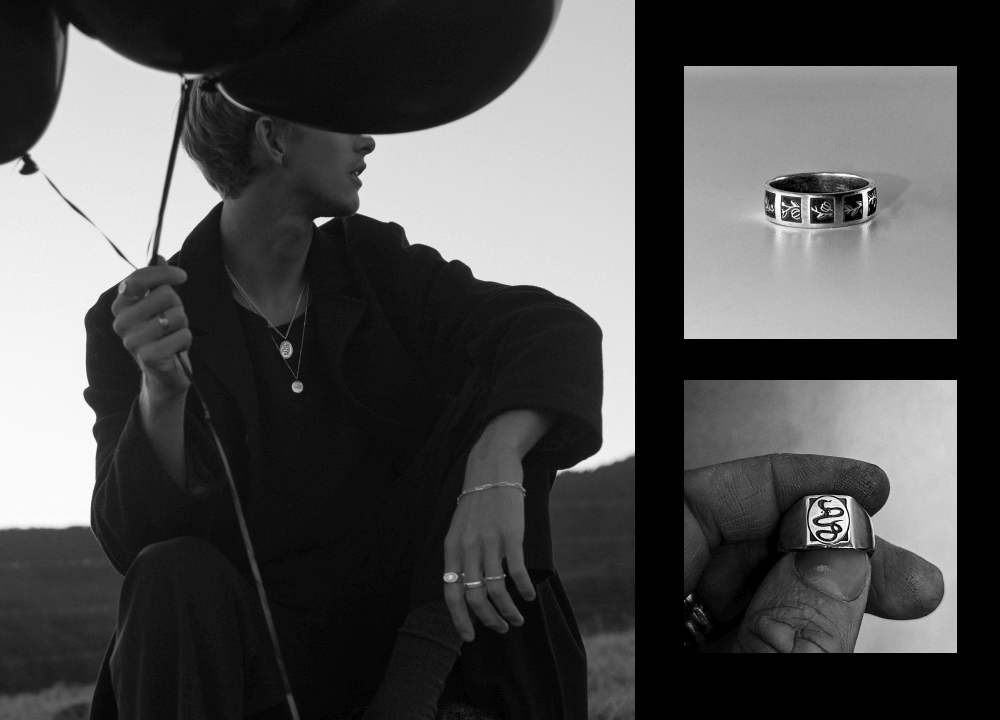
Above: Sue The Boy
When we think about jewellery, the first thing that comes to mind is usually engagement rings, or perhaps, beautiful women adorned in diamonds, pearls, or gemstones. While you wouldn’t be wrong, as societal norms and preferences evolve, we are witnessing a notable shift in appreciation for men’s jewellery. Global sales in the category continue to grow year-on-year, according to market research by Euromonitor International. Men are embracing adornment with newfound enthusiasm, steeped in a spirit of exploration, fun and adventure.
Director of Keda Konsulting, Richard Morgan notes the most obvious examples of men’s jewellery as the inclusion of accessories, such as beads and bracelets, and of course, watches – a timeless symbol of men’s decoration. “There’s a real trend in dressing up what we already have. Though in recent years, there has been a noticeable shift towards men becoming more adventurous with their style and embracing jewellery as a means of self-expression, whether it be earrings, bracelets or necklaces,” he explains.
Richard Morgan emphasises that this trend signifies a deviation from conventional and conservative choices, allowing men to confidently show their style. The demand for statement rings, bracelets, and the use of unconventional materials highlights men’s increasing inclination to use jewellery to make fashion statements, highlighting individuality and self-expression. Morgan adds that diamond studs are particularly sought-after items among men, showcasing style and class. He also adds that, of course, watches will remain a primary adornment worn by men.
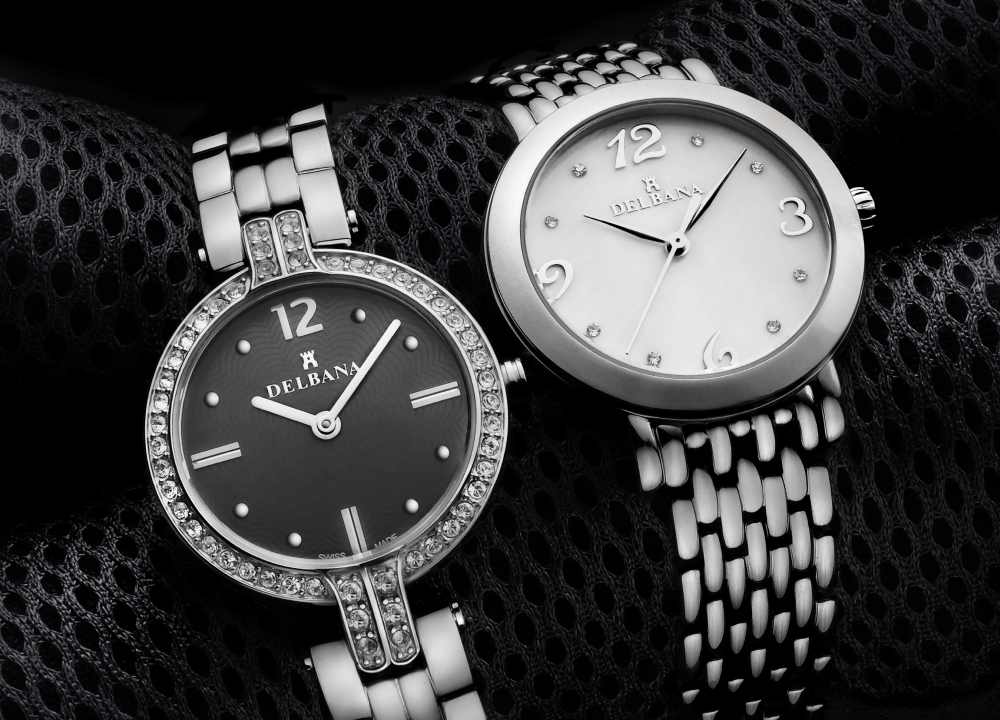
Above: Delbana, courtesy of Keda Konsulting
John Rose, the chief executive officer of West End Collection has also noticed this evolution in trends. “Traditionally, men purchased jewellery for business use with items such as cufflinks, tie bars and money clips being very popular. Today, men’s jewellery is far more popular as a fashion accessory. The key trend that we are experiencing in both Maserati men’s jewellery and Paul Hewitt men’s jewellery is the increased demand for bracelets,” he says.
Darren Roberts, chief executive officer of Cudworth, highlights the gaining popularity of pearls paired with beads in men’s designs. This combination is a modern twist to tradition, capturing sophisticated whimsy. Roberts also mentions the rising trend of colourful Milano rope bracelets, which have captured the attention of fashion-forward men.
Harley Wearne, founder of Sue The Boy, describes a noticeable change in this sector, saying “There’s definitely a shift towards men being more adventurous with their style and embracing jewellery as a way to express themselves. We are having guys coming into the studio never having worn a ring and walking out with three.”
“[Jewellery] is no longer seen as solely a symbol of wealth or status but rather as a form of self-expression, and we are now, more than ever influenced by the people adorning our social media, bringing us this inspiration. This shift has influenced our approach to promoting men’s jewellery by highlighting versatility, contemporary designs, and the ability to add a unique touch to any outfit,” adds Richard Morgan.
Phil Edwards, the owner of Duraflex, details a significant broadening in the scope of design across gender, specifically regarding watches. “One of the biggest trends to emerge from Watches & Wonders [was] brands launching mid-size, unisex dial sizes… not gender specific. A significant shift forward and leaving the categorisation of what was traditionally men’s or ladies in the past,” he says.
According to John Rose, there are notable differences in the trends between men’s and women’s jewellery. He observes that men typically prefer larger pieces, built to withstand wear and tear, rendering stainless steel a highly sought-after material in this category. He, too, highlights the rising trend of leather bracelets among men, indicating a shift in their preferences. John says, “The men’s jewellery category is definitely increasing as it has become more fashionable for men to accessorise their looks. Designs have changed from being very conservative in the past to becoming more and more adventurous as we move forwards.”
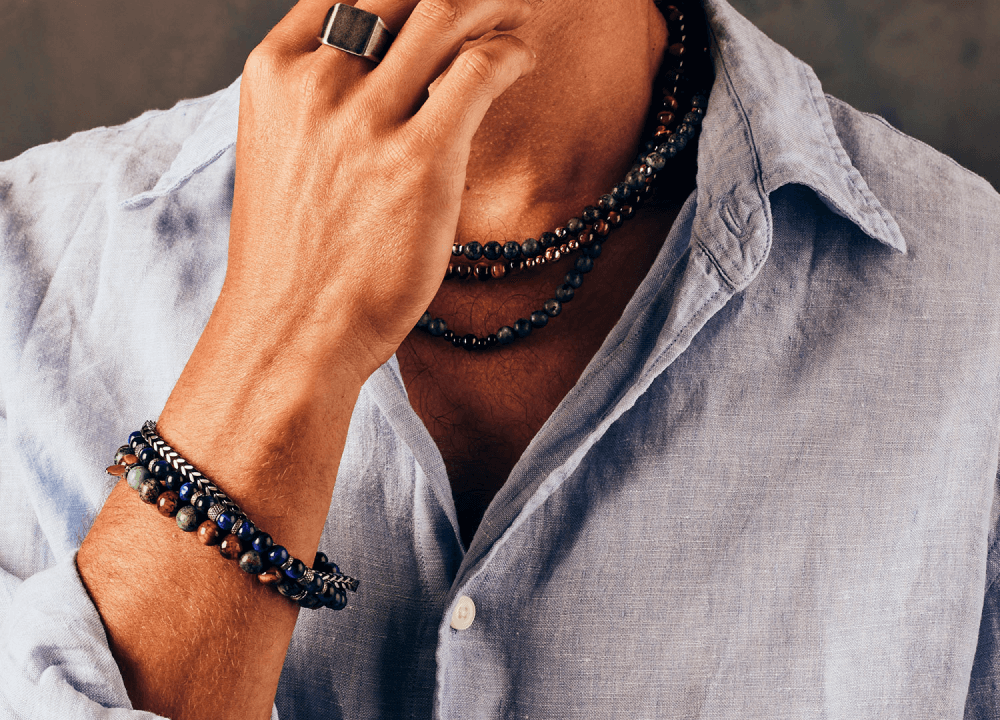
Above: Cudworth
When asked about the most popular materials in men’s jewellery, Darren Roberts mentions the company’s traditional focus. “We traditionally work with stainless steel and sterling silver mixed with leather, semi-precious stones and pearls,” he says. These metals are known for their durability and timeless appeal, making them desirable choices for men’s accessories.
When it comes to materials, Wearne notes that gold is trending in men’s designs. However, the price point of gold, particularly for heavier signet rings, continues to keep many men opting for silver. “I think both will always have a place. Sue The Boy started with a more organic hand-carved look and has slowly moved into a bit of a cleaner polished look which I think would have lost some of our audience but gained others in the process. I feel younger males [appreciate] seeing some scuffs/marks and imperfections to make it feel artisan made,” he says.
Richard Morgan notes that specific demographics and consumer segments are driving the growing popularity of men’s jewellery. Among them, younger generations, celebrities, and influencers play a pivotal role. Particularly influential is the purchasing power held by Millennial and Gen Z consumers, who prioritise self-expression and individuality in their style choices. Their inclination to embrace jewellery as a form of expression has greatly increased the popularity and variability of men’s jewellery today.
Attesting to the younger demographics driving current trends, John Rose says, “When comparing the demographics of men who were buying jewellery five to ten years ago to those of today, we notice that the audience is far broader. With the trends moving towards fashion jewellery, more younger men are wearing jewellery now than they were previously. The ‘business use’ jewellery remains a key demographic for men. However, the fashion category is the fastest growing, which attracts a very different and broader audience.”
Darren Roberts points to the changing preferences of customers, revealing he has seen an increase in requests for vegan leather, demonstrating the desire for ethically-conscious materials. With Cudworth, he ensures the brand caters to the diverse preferences of its customers while staying true to its commitment to quality and innovation. Richard Morgan adds that he anticipates “continued growth in the men’s jewellery market. As for trends, colour palettes are always an evolution in design factor – watch dials will always be the leader here and all other jewellery complements in most cases.”
Richard Morgan further explains that personalised experiences and storytelling will be essential in establishing a solid connection with male consumers when it comes to marketing strategies. To meet the ever-changing needs and preferences of male consumers, it is crucial to continuously assess market trends, conduct thorough consumer research, and actively engage with your target audience. John Rose is excited for such changes to come. “As we look forward, we anticipate more and more pieces [that] push the boundaries to make the most impressive statement when these pieces are worn,” he says.
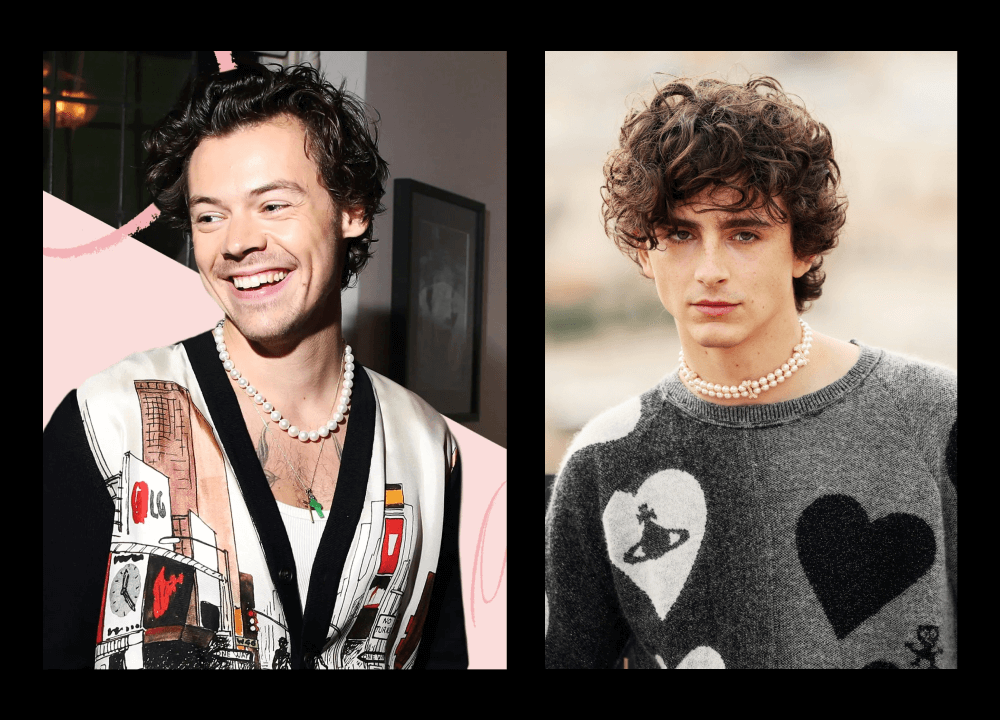
Above: Harry Styles and Timotheé Chamalet
Darren Roberts also points to the role of social media and celebrity influence, noting how social media has played a significant role in showcasing celebrities wearing men’s jewellery, expanding the perceptions and embrace of jewellery for men. Seeing cultural influencers like Harry Styles, A$AP Rocky, and Timothèe Chalamet embracing jewellery has made men feel more free and confident to incorporate jewellery into their style.
Harley Wearne also confirms that attitudes towards men’s jewellery have significantly changed in recent years. People are more open with their fashion choices, allowing designers like Sue The Boy to experiment and push boundaries. Wearne acknowledges the influence of pop culture and film, where male jewellery placement and shots have become more prevalent. These factors have undoubtedly contributed to the rising popularity of men’s jewellery, especially among younger demographics.
When creating personalised or custom-made men’s jewellery, Sue The Boy’s Unadorned collection serves as a great example. This collection offers a range of plain-faced rings in various shapes, which can be tailored to suit individual preferences. Wearne and his team work closely with clients to create bespoke pieces that align with their desired style and vision, an essential factor in this consumer base.
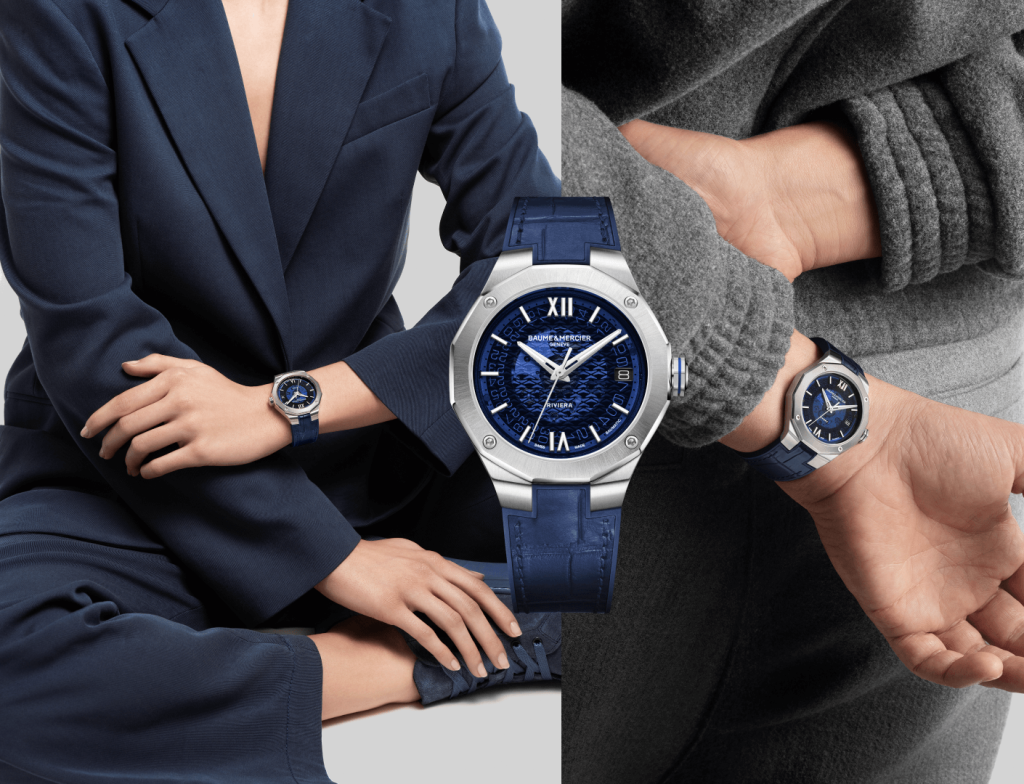
Above: Baume & Mercier, courtesy of Duraflex
Richard details that there has been a consistent demand for watches that incorporate modern and classic features that focus on sustainability. In the future, he predicts that the industry can expect “more integration of technology, sustainability efforts, and innovative designs.” There is also a positive surge in demand for vintage-inspired watches, with many sales heading towards smaller case sizes. “On a serious note, the watch market is the strongest I’ve seen, with desirability at its peak in some areas. With the right marketing strategy, support and training from the brands, it’s an area that can work well,” he adds.
John Rose shares insight into West End Collection’s diverse watch portfolio, catering to a wide range of preferences. Rose points out that the premium fashion category, featuring brands like Maserati, is experiencing rapid growth. He further highlights the sustained popularity of Swiss watches, with brands such as Maurice Lacroix performing exceptionally well in the market. Rose mentions that while many men opt for smartwatches to wear during work hours, it may be considered a fashion faux pas to sport this style of watch when socialising at events. Men are increasingly willing to invest the same amount of money they would spend on an Apple Watch on a sophisticated dress watch, reflecting their changing preferences and priorities.
Phil Edwards also notes Duraflex’s need for both traditional and smartwatches. “For the Swiss watch brands that we distribute, the rise of smartwatches has not seen any great impact on the luxury market. The rise of smartwatches has predominantly impacted the under $1000 watch market, however, the motivations for purchasing smartwatches now differ quite significantly from traditional watches,” he says.
The world of men’s jewellery has undergone many transformations in recent years. From classic pieces of sophistication to unconventional choices that make a statement, men are now embracing jewellery as a powerful means of self-expression. As we move forward, it remains certain that the market for men’s jewellery and watches will continue to evolve, expand, and inspire the new age of fashion.
Further reading: